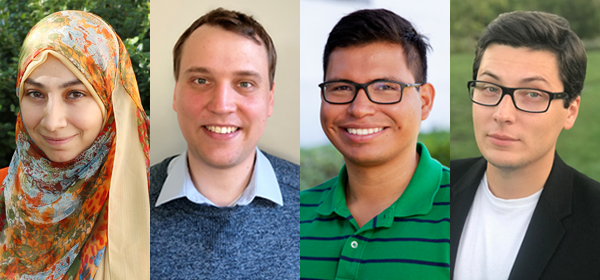Four Assistant Professors Win NSF CAREER Awards

June 28, 2024 - Four UC Irvine engineering assistant professors – Salma Elmalaki, Perry Johnson, Christopher Olivares Martinez and Maxim Shcherbakov -- have been recognized this year with Faculty Early Career Development (CAREER) awards from the National Science Foundation. Among NSF’s most prestigious honors, the CAREER award supports young faculty who are academic role models in research and education.
Elmalaki, electrical engineering and computer science, will receive $575,000 over five years from the Division of Computer and Network Systems. Her research aims to design innovative decision-making algorithms for cyberphysical (CPS) systems that consider both the physical aspects of the systems and the complex social-psychological nature of human interactions with these systems.
The rise of smart technologies has enabled a new era of human-technology interaction, which presents tremendous opportunities for a more equitable and privacy-aware societal scale of CPS but also poses formidable challenges. Elmalaki believes that comprehending the intricate relationships between CPS and humans is essential for shaping equitable societal outcomes in future technologies. With this project, she seeks to bridge gaps in current CPS engineering practices by incorporating social-psychological dynamics and societal considerations into innovative solutions. By developing new algorithms, models and tools that seamlessly integrate these dynamics, her research aims to provide a valuable resource for researchers and practitioners in the field. "Such psychologically aware decision-making algorithms will enable harmonious interactions, foster equity and optimize overall performance," said Elmalaki.
Johnson, mechanical and aerospace engineering, is the recipient of $500,000 over five years from the Division of Chemical, Bioengineering, Environmental and Transport Systems.
Johnson’s project aims to reshape our understanding of turbulent boundary layers and how to predict their dynamics. Turbulence plays a key physical role in a wide variety of boundary layer flows related to energy, transportation and national security. As such, improving simulation capabilities for boundary layer turbulence holds the key to accelerating engineering design, optimization and certification while reducing associated costs.
These boundary layers are thin layers of fluid -- air or water -- adjacent to the immersed body such as an airplane, ship, submarine or wind turbine blade. The performance and efficiency of these vehicles and devices depend crucially on the fluid dynamics in these thin layers. Johnson’s research focuses on two critical areas: the interaction of boundary layers with pressure gradients, which are caused by aerodynamic shaping, crucial for understanding phenomena like turbulent boundary layer separation and its impact on aerodynamic drag; and high-speed effects relevant to hypersonic vehicles. The goal is to develop a new method that is a more cost-effective solution, making it invaluable for design optimization and certification processes in advanced airplane concepts.
Olivares Martinez, civil and environmental engineering, is investigating the impact of wildland-urban interface fires on water quality. He was awarded $559,788 from the Division of Chemical, Bioengineering, Environmental and Transport Systems.
“It was just six years ago, when the world learned about the first reports on volatile cancer-causing chemicals in tap water following fires,” said Olivares Martinez. “Our research aims to understand how these chemicals impact the microbial safety of tap water, something we don’t know anything about.”
As fires become more frequent and severe due to climate change, it is important for researchers and policymakers to understand and mitigate the adverse impacts on drinking water quality and distribution systems. When fires occur at the wildland-urban interface, where humans and their built environment meet and interact with wildland vegetation, the plastic components of drinking water pipes and distribution networks can undergo combustion and chemical breakdown releasing toxic substances including benzene, toluene, styrene and vinyl chloride. These chemicals can contaminate drinking water and promote the growth of microorganisms and harmful pathogens for several months following fires.
Olivares Martinez’s project will look at the release and continued presence of high concentrations of chemicals in water distribution systems following wildfires and if they consume any residual disinfectant in the systems. He will also see if the remaining toxins will metabolize and support the growth of harmful microorganisms in tap water. With his findings, Olivares Martinez hopes to contribute to developing climate adaptation treatments to protect water quality and public health after fires and other climate change disasters.
Shcherbakov, electrical engineering and computer science, was awarded $550,000 from the Division of Electrical, Communications and Cyber Systems for his project to improve photonic devices.
Photonics is a powerful technology that enables ever-growing data transfer and inspires novel energy-efficient and reconfigurable architectures that will empower the computers of the future. However, the present diversity of colors in photonic chips calls for a universal approach to transfer signals from one light frequency to another. Currently, chips carry near-infrared signals for communication, visible signals for imaging and mid-infrared for thermal radiation and sensing applications. Conversion between these chips through electronics-driven detection and emission is slow and inefficient.
Shcherbakov’s research will address the problem of efficient frequency conversion on a chip. His project aims to bridge the gap between mid-, near-infrared and visible photonics at the nanoscale by exploring nanostructures called photonic-photonic metasurfaces. He will connect signals across five octaves of light through nonlinear and quantum light-matter interactions. His project proposes to use modern tools of nanotechnology, as well as rigorous numerical design approaches and state-of-the-art optical testing tools, including femtosecond lasers and single-photon correlation techniques. He says, “the results will pave the way to better, more efficient signaling on a chip, enabling advancements in on-chip photonics, impacting computing, signal processing, telecommunication, quantum information and medical imaging technologies.”
– Lori Brandt
